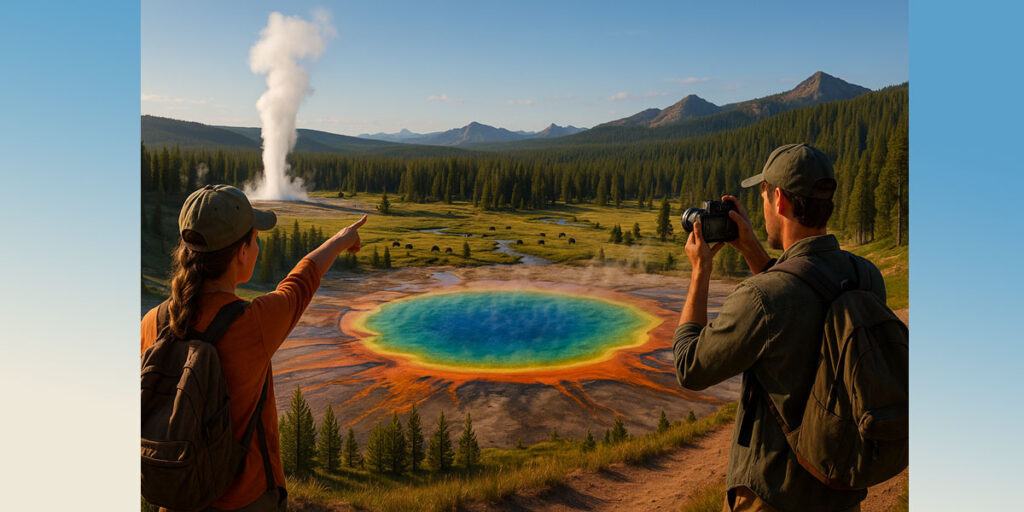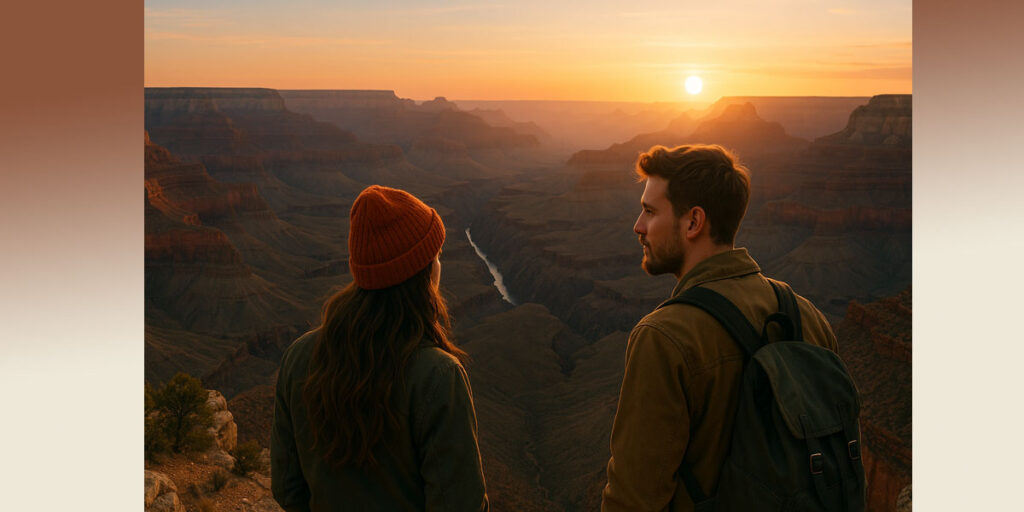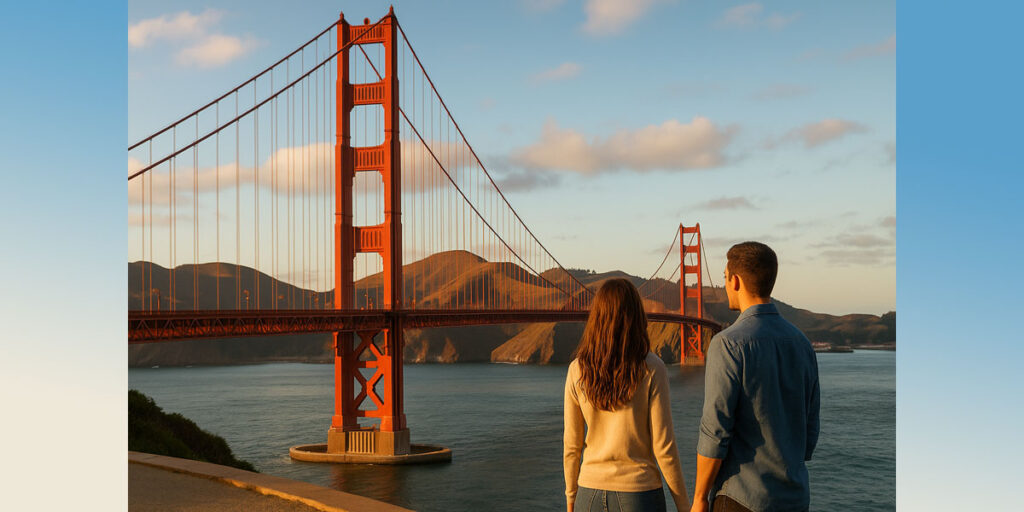Why was Yellowstone chosen as the first national park in the world?
Long before the world truly understood the value of conservation, a team of explorers ventured into a mystical land in 1870 that seemed straight out of legend—steaming geysers, vibrant hot springs, vast canyons, and forests where elk and bison roamed freely. When the Washburn–Langford–Doane Expedition returned, they didn’t ask to claim the land—they asked to protect it. The breathtaking landscape sparked awe and urgency among lawmakers. Just two years later, in 1872, President Ulysses S. Grant signed the Yellowstone National Park Protection Act into law. Thus, Yellowstone, lying mostly in Wyoming but stretching into Montana and Idaho, became the world’s first national park—a global pioneer in the idea that nature, in all its wild beauty, should belong to no one and everyone at once.
What makes the geography of Yellowstone so extraordinary and otherworldly?
Deep beneath Yellowstone’s pristine forests and mirror-like lakes lies a sleeping giant: a supervolcano. This massive magma chamber breathes life into the land above it, forming more than 10,000 hydrothermal features—hot springs that shimmer like rainbows, steaming fumaroles that whisper to the skies, and geysers like Old Faithful, which shoots water over 100 feet high at remarkably regular intervals. The park also cradles dramatic canyons carved by the Yellowstone River, alpine meadows where grizzlies roam, and lakes so large they create their own weather. It’s not just a park—it’s a living, shifting landscape sculpted by fire, ice, and time.
When is the best time to visit Yellowstone, and what can each season reveal?
Each season in Yellowstone is like opening a new chapter in an adventure novel. Summer, from June to August, welcomes the most visitors with warm days perfect for hiking, wildlife watching, and geyser gazing—but it also brings crowds. Spring, especially May, is a secret gem—baby animals emerge, wildflowers bloom, and waterfalls roar with snowmelt. Fall, from mid-September to October, paints the landscape in gold and amber while elk bugle across valleys in primal symphonies. And then there’s winter—quiet, white, and magical. Only a few areas stay open, accessible by snowcoach or ski, but bison plowing through snowdrifts and steaming geysers in a frost-kissed forest make it feel like you’ve stepped into another world.
How did Native American tribes interact with Yellowstone long before it became a park?
Centuries before Yellowstone appeared on any government map, it was already home. Tribes like the Shoshone, Crow, Bannock, and Blackfeet knew these lands intimately. They followed bison herds across sweeping plains, fished the teeming rivers, and passed down sacred stories about the colorful geysers and smoking springs. The Shoshone, in particular, lived in what is now Yellowstone’s western region, adapting to high-altitude life with skill and reverence. To them, the steaming ground wasn’t strange—it was spiritual. The land provided warmth, food, medicine, and myth. While early white explorers thought Yellowstone was an untouched wilderness, Native people had walked its valleys, climbed its ridges, and honored its mysteries for over 11,000 years.
What role does the Yellowstone River play in shaping the park’s stunning scenery?
The Yellowstone River, wild and untamed, begins high in the Absaroka Range and flows northward, carving its mark into the land like a painter’s boldest stroke. One of its greatest masterpieces is the Grand Canyon of the Yellowstone—a deep, multicolored chasm with golden walls and thunderous waterfalls. As the river winds through the park, it feeds the ecosystems around it, offering life to bears, otters, elk, and bald eagles. Unlike most rivers, it flows north, defying convention and fueling the powerful Lower and Upper Falls. With every rushing drop, the Yellowstone River continues a story millions of years in the making, its roar echoing through canyons and time alike.
Why is Yellowstone considered one of the best places in the U.S. for wildlife watching?
Imagine a dawn drive through Hayden Valley. Mist rises off the grasslands like a curtain lifting on a theater stage. A bison herd grazes in the distance, steam from their nostrils catching the morning light. Suddenly, a wolf darts from the tree line, and high above, an eagle circles. Yellowstone is one of the few places in the lower 48 states where all native large mammals still roam free—grizzly bears, wolves, elk, moose, bison, and mountain lions. Thanks to careful conservation and vast protected lands, it’s a living Noah’s Ark. Visitors often find themselves just a safe distance from these majestic animals, cameras clicking, hearts racing, as nature plays out its ancient drama right before their eyes.
What makes Old Faithful such a beloved symbol of Yellowstone?
In a land where steam whistles from the earth and colors bloom from boiling springs, one geyser stands as Yellowstone’s proud herald—Old Faithful. Discovered by the Washburn Expedition in 1870, this geyser quickly earned its name not just for its grandeur but its reliability. Roughly every 90 minutes, it erupts with a spectacular burst of water and steam, reaching up to 180 feet into the air. Crowds gather on benches, holding their breath, until the first droplets break through, followed by a thunderous tower of mist. While not the tallest geyser, its dependable display is nature’s timekeeper—a ritual that has mesmerized millions and marked the heartbeat of Yellowstone for over 150 years.
How did the massive Yellowstone fires of 1988 change the park forever?
In the summer of 1988, the skies over Yellowstone darkened not with storm clouds, but with smoke. A mix of lightning and drought sparked wildfires that swept through over 790,000 acres of the park. For weeks, flames consumed old forests, and smoke turned day to dusk. Many feared Yellowstone would never recover. But nature had a different plan. Within a year, green shoots pushed through the blackened ground. Lodgepole pines, whose cones require fire’s heat to release seeds, began to thrive. Scientists call it a rebirth—the fire, though fierce, became part of the park’s long ecological cycle. Today, visitors walk among thriving forests that owe their beauty to flames of the past.
Why does Yellowstone feel like stepping into a prehistoric world?
Stand at Mammoth Hot Springs and watch mineral terraces cascade like frozen waterfalls, or walk the steaming boardwalks of Norris Geyser Basin and smell sulfur rising from Earth’s depths—this is a place unlike anywhere else. Yellowstone sits atop a vast volcanic hotspot, one of the most geologically active places on Earth. The very ground feels alive. Combined with the roaming herds of bison, the haunting calls of wolves, and the primeval silence that blankets its forests, Yellowstone evokes an ancient world untouched by time. It’s easy to imagine dinosaurs in these valleys or ancient tribes whispering legends by firelight. Yellowstone doesn’t just preserve nature—it preserves a feeling, a doorway into Earth’s wild, primordial soul.
How did Yellowstone’s creation influence national parks around the world?
When Congress established Yellowstone as a national park in 1872, it wasn’t just an American milestone—it lit a spark across the globe. The idea that a government would preserve a vast natural landscape “for the benefit and enjoyment of the people” was revolutionary. Soon after, countries like Canada, Australia, and New Zealand began protecting their own wild wonders. Yellowstone became a model, a symbol that nature deserved guardianship, not ownership. The park’s creation inspired a movement—a network of protected lands that now stretches from Patagonia to the Serengeti, from the Himalayas to the Arctic. In many ways, Yellowstone was Earth’s first whisper that its most sacred places should be shared, not spoiled.
What is the significance of the Grand Prismatic Spring’s vivid colors?
As you ascend the trail near Midway Geyser Basin, a surreal sight comes into view—a vast, circular spring that shimmers with the colors of a rainbow. This is Grand Prismatic Spring, the largest hot spring in the United States and one of the most photographed features in Yellowstone. Its center glows deep blue, while fiery reds, oranges, and yellows ripple outward like molten jewels. The colors aren’t painted—they’re alive. Microbial mats, thriving in the mineral-rich waters, produce pigments based on the temperature of the water. The result? A natural kaleidoscope powered by heat, chemistry, and biology. It’s not just beautiful—it’s a window into microbial life that may resemble the origins of life on Earth itself.
What’s it like to explore Yellowstone by night?
When the sun dips below the peaks and the last tour buses rumble away, Yellowstone transforms. The park’s vast wilderness becomes a realm of shadows, whispers, and starlight. Geysers still erupt, but their steam glows silver under the moon. Owls call from the treetops, and if you’re lucky, you might hear wolves howling in the distance—a sound that feels both ancient and electric. With minimal light pollution, the sky becomes a cathedral of stars, and in the summer, the Milky Way paints itself across the heavens. Night hikes, ranger-led astronomy programs, and quiet campfires reveal a side of Yellowstone most visitors never see. It’s a time when the wild reclaims the silence, and the park feels like it’s breathing secrets only the night can hear.
How do the geothermal features of Yellowstone connect to its volcanic past?
Beneath Yellowstone’s surface lies an immense caldera formed by one of the most powerful volcanic eruptions in Earth’s history, some 640,000 years ago. The explosion reshaped the land, leaving behind a collapsed magma chamber that now fuels the park’s thousands of geothermal features. Geysers, bubbling mud pots, hissing fumaroles, and vibrant hot springs are not random wonders—they are the breathing pores of an ancient volcano still very much alive. Scientists closely monitor the park for shifts in temperature, ground deformation, and seismic activity. Though the volcano sleeps, its power still simmers just below, reminding visitors that Yellowstone is not just a park—it’s a living, geological marvel created by fire and time.
Why is the Lamar Valley often called “America’s Serengeti”?
Early morning in Lamar Valley feels like entering a lost world. Located in the northeastern corner of Yellowstone, the valley opens wide with golden meadows and slow-moving rivers, framed by snow-capped peaks. But it’s not just the scenery that stirs the heart—it’s the abundance of wildlife. Wolves hunt in coordinated packs. Grizzly bears dig for roots. Elk, bison, coyotes, pronghorns, and bald eagles all make their homes here. The diversity is so rich, so vibrant, that wildlife watchers and photographers from around the globe come here for a chance to witness nature’s raw drama unfold. It’s no wonder the valley has earned the title “America’s Serengeti”—a wild theatre where predators and prey perform under open skies.
What role do Yellowstone rangers play in protecting the park’s fragile balance?
Clad in olive green and tan, Yellowstone’s rangers are more than guides—they’re storytellers, scientists, firefighters, and guardians of a sacred land. From leading tours through geyser basins to monitoring wildlife populations and rescuing stranded hikers, their roles are as dynamic as the park itself. They enforce rules that protect both people and animals, educate millions of visitors each year about preservation, and respond swiftly when danger threatens. During bear encounters, wildfires, or even flash floods, they are first on the scene. Quietly and tirelessly, they ensure Yellowstone remains as wild and wondrous for future generations as it was for those who first glimpsed its steaming valleys and roaring falls over 150 years ago.
How did the reintroduction of wolves change Yellowstone’s ecosystem?
In 1995, a quiet truck rolled into Yellowstone carrying precious cargo—grey wolves, absent from the park since the 1920s due to overhunting. Their return marked the beginning of one of the most profound ecological experiments in modern conservation. At first, many worried: Would they attack livestock? Would they stay? But as wolves settled in, something remarkable happened. Elk populations, once unchecked, began to decline and move more cautiously. Willows, aspens, and cottonwoods grew back along streams. Birds returned. Beavers multiplied. Even rivers changed course due to stabilized banks. It was a textbook case of a trophic cascade—how one apex predator, by restoring balance, reshaped an entire ecosystem. Yellowstone wasn’t just healing—it was singing again.
What makes Yellowstone Lake so mysterious and unique?
Yellowstone Lake stretches across the heart of the park like a shimmering mirror, its surface calm, but its depths hiding volcanic secrets. At over 7,700 feet above sea level, it’s one of North America’s largest high-altitude lakes. But what truly makes it fascinating lies beneath the water. Submerged hydrothermal vents release plumes of heat and minerals, forming bizarre underwater landscapes and supporting microscopic life that thrives in extreme conditions. Scientists exploring the lakebed have discovered geysers, craters, and even dome-like structures rising from the floor. Despite its serene appearance, Yellowstone Lake is as alive and dynamic as the land around it—a quiet giant atop an ancient caldera.
Why is Yellowstone a place of inspiration for artists, writers, and dreamers?
From early painters like Thomas Moran, whose dramatic watercolors helped convince Congress to protect the park, to modern poets and photographers seeking solitude, Yellowstone has long stirred the creative soul. Its vast skies, untamed wildlife, and surreal thermal features invite wonder and introspection. Standing by a geyser or watching a bear cross a valley isn’t just a moment—it’s a story, a symbol of Earth’s raw power and beauty. For many, Yellowstone isn’t just a place to visit; it’s a place to feel small and connected all at once, where the wild can speak, and inspiration bubbles up like steam from a hot spring, waiting to be turned into art, music, or memory.
What ancient secrets lie in Yellowstone’s fossil forests?
High in the northern Absaroka Range, nestled within the park’s less-traveled terrain, lies one of Yellowstone’s quietest wonders—the Petrified Forests. These are not modern trees frozen in time, but ancient giants from over 50 million years ago, turned to stone by volcanic ash and mineral-rich waters. Whole forests were buried during massive eruptions, and over time, the organic material was replaced with quartz, preserving the trunks in dazzling detail. Today, some stand upright, rooted where they once grew—silent witnesses to a prehistoric world where subtropical plants thrived. These fossilized giants whisper of a time when Yellowstone was more jungle than mountain, and offer rare insight into life before the modern Rockies ever rose.
How is Yellowstone a window into Earth’s future as well as its past?
Yellowstone is often seen as a relic of Earth’s ancient forces, but scientists also see it as a living laboratory for what lies ahead. The geothermal systems teach us about sustainable energy. Its wildlife management shows the delicate balance between nature and humanity. The park’s dynamic geology gives clues to future volcanic activity, and how Earth’s crust evolves over time. Researchers studying microbes in hot springs even believe they may unlock secrets about life on other planets. From climate monitoring to species migration, Yellowstone isn’t just a place for reflection—it’s a crucible of discovery, helping scientists understand not only what Earth was, but what it may become.
Why does Yellowstone capture the hearts of millions year after year?
There’s a moment in every Yellowstone journey—whether standing beside a geyser’s roar, hearing wolves at dusk, or watching the sun set over Lamar Valley—when time seems to pause. Visitors come for different reasons: families on summer trips, photographers chasing light, hikers craving silence, and children seeing bison for the first time. But they all leave with something more than photos. It’s the feeling of vastness, of wildness that still exists in a crowded world. Yellowstone touches something primal—an echo of the Earth as it once was. It’s not just a national park; it’s a living storybook where every rock, river, and tree reminds us of our place in the grand, beautiful web of life.
How does Yellowstone teach us about the power—and patience—of nature?
In Yellowstone, nature reveals itself not in a rush, but in rhythms that span millennia. Geysers like Old Faithful may erupt every hour, but others—like Steamboat—lie dormant for years before suddenly springing to life with the force of a volcano. Trees grow in the shadows of thermal basins, waiting decades to reach maturity. Lava flows, glacial scouring, and tectonic shifts have shaped the land over millions of years. Visitors often come expecting quick thrills, but Yellowstone rewards those who linger, who walk slowly, who watch quietly. It teaches us that true wonder doesn’t always shout—it simmers, it evolves, and sometimes, it waits a thousand years before blooming into beauty.
What role do fire and renewal play in Yellowstone’s landscape?
At first glance, wildfire might seem like destruction—but in Yellowstone, it’s part of nature’s design. Trees like lodgepole pines have cones that only release seeds under intense heat, meaning fire actually plants the next forest. After the 1988 fires scorched nearly a third of the park, many feared it was a catastrophe. Yet just months later, meadows glowed green, wildflowers returned, and saplings rose from the ashes. Fire clears out old growth, recycles nutrients, and creates habitat for countless species. It’s not just a force of change—it’s a force of rebirth. In Yellowstone, even the flames carry a promise: from ruin comes renewal, from ash comes life.
Why is Yellowstone more than just a collection of natural wonders?
Yellowstone isn’t just geysers and canyons, rivers and bison—it’s an idea. A promise made in 1872 that this place, in all its wild majesty, would be preserved for everyone, forever. It was the beginning of the national park concept, an act of hope that said wilderness has value beyond what it can be sold for. Every trail, every overlook, every steaming vent is part of a greater story about how people and nature can coexist. Whether you visit for a day or stay for a week, Yellowstone becomes part of you. It’s not just a place you remember—it’s a place that remembers you.






